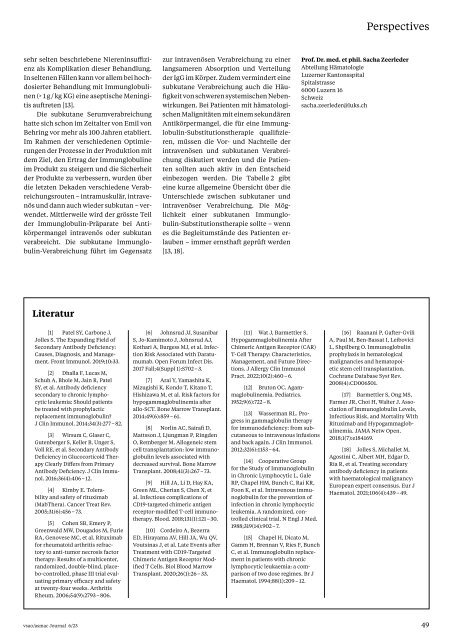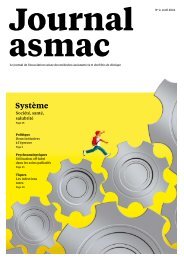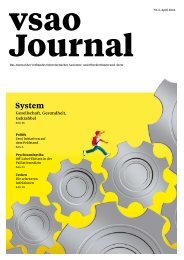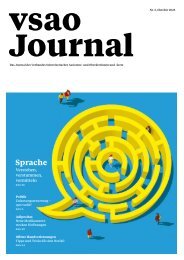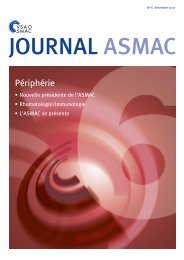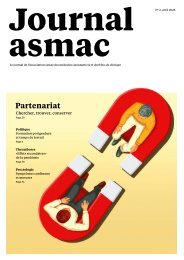Journal asmac No 6 - décembre 2023
Sauvetage - Histoires d’hôpitaux et de carottes Politique - Un guide sur la santé planétaire Médecine du sport - Prévention et traitement des blessures Déficits immunitaires secondaires - La substitution par immunoglobulines en hématologie
Sauvetage - Histoires d’hôpitaux et de carottes
Politique - Un guide sur la santé planétaire
Médecine du sport - Prévention et traitement des blessures
Déficits immunitaires secondaires - La substitution par immunoglobulines en hématologie
You also want an ePaper? Increase the reach of your titles
YUMPU automatically turns print PDFs into web optimized ePapers that Google loves.
Perspectives<br />
sehr selten beschriebene Niereninsuffizienz<br />
als Komplikation dieser Behandlung.<br />
In seltenen Fällen kann vor allem bei hochdosierter<br />
Behandlung mit Immunglobulinen<br />
(> 1 g / kg KG) eine aseptische Meningitis<br />
auftreten [13].<br />
Die subkutane Serumverabreichung<br />
hatte sich schon im Zeitalter von Emil von<br />
Behring vor mehr als 100 Jahren etabliert.<br />
Im Rahmen der verschiedenen Optimierungen<br />
der Prozesse in der Produktion mit<br />
dem Ziel, den Ertrag der Immunglobuline<br />
im Produkt zu steigern und die Sicherheit<br />
der Produkte zu verbessern, wurden über<br />
die letzten Dekaden verschiedene Verabreichungsrouten<br />
– intramuskulär, intravenös<br />
und dann auch wieder subkutan – verwendet.<br />
Mittlerweile wird der grösste Teil<br />
der Immunglobulin Präparate bei Antikörpermangel<br />
intravenös oder subkutan<br />
verabreicht. Die subkutane Immunglobulin-Verabreichung<br />
führt im Gegensatz<br />
zur intravenösen Verabreichung zu einer<br />
langsameren Absorption und Verteilung<br />
der IgG im Körper. Zudem vermindert eine<br />
sub kutane Verabreichung auch die Häufigkeit<br />
von schweren systemischen Nebenwirkungen.<br />
Bei Patienten mit hämatolo gischen<br />
Maligni täten mit einem sekundären<br />
Antikörpermangel, die für eine Immunglobulin-Substitutionstherapie<br />
qualifizieren,<br />
müssen die Vor- und Nachteile der<br />
intravenösen und subkutanen Verabreichung<br />
diskutiert werden und die Patienten<br />
sollten auch aktiv in den Entscheid<br />
einbezogen werden. Die Tabelle 2 gibt<br />
eine kurze allgemeine Übersicht über die<br />
Unterschiede zwischen subkutaner und<br />
intravenöser Verab reichung. Die Möglichkeit<br />
einer subkutanen Immunglobulin-Substitutionstherapie<br />
sollte – wenn<br />
es die Begleitumstände des Patienten erlauben<br />
– immer ernsthaft geprüft werden<br />
[13, 18].<br />
Prof. Dr. med. et phil. Sacha Zeerleder<br />
Abteilung Hämatologie<br />
Luzerner Kantonsspital<br />
Spitalstrasse<br />
6000 Luzern 16<br />
Schweiz<br />
sacha.zeerleder@luks.ch<br />
Literatur<br />
[1] Patel SY, Carbone J,<br />
Jolles S. The Expanding Field of<br />
Secondary Antibody Deficiency:<br />
Causes, Diagnosis, and Management.<br />
Front Immunol. 2019;10:33.<br />
[2] Dhalla F, Lucas M,<br />
Schuh A, Bhole M, Jain R, Patel<br />
SY, et al. Antibody deficiency<br />
secondary to chronic lymphocytic<br />
leukemia: Should patients<br />
be treated with prophylactic<br />
replacement immunoglobulin?<br />
J Clin Immunol. 2014;34(3):277 – 82.<br />
[3] Wirsum C, Glaser C,<br />
Gutenberger S, Keller B, Unger S,<br />
Voll RE, et al. Secondary Antibody<br />
Deficiency in Glucocorticoid Therapy<br />
Clearly Differs from Primary<br />
Antibody Deficiency. J Clin Immunol.<br />
2016;36(4):406 – 12.<br />
[4] Kimby E. Tolerability<br />
and safety of rituximab<br />
(MabThera). Cancer Treat Rev.<br />
2005;31(6):456 – 73.<br />
[5] Cohen SB, Emery P,<br />
Greenwald MW, Dougados M, Furie<br />
RA, Genovese MC, et al. Rituximab<br />
for rheumatoid arthritis refractory<br />
to anti-tumor necrosis factor<br />
therapy: Results of a multicenter,<br />
randomized, double-blind, placebo-controlled,<br />
phase III trial evaluating<br />
primary efficacy and safety<br />
at twenty-four weeks. Arthritis<br />
Rheum. 2006;54(9):2793 – 806.<br />
[6] Johnsrud JJ, Susanibar<br />
S, Jo-Kamimoto J, Johnsrud AJ,<br />
Kothari A, Burgess MJ, et al. Infection<br />
Risk Associated with Daratumumab.<br />
Open Forum Infect Dis.<br />
2017 Fall;4(Suppl 1):S702 – 3.<br />
[7] Arai Y, Yamashita K,<br />
Mizugishi K, Kondo T, Kitano T,<br />
Hishizawa M, et al. Risk factors for<br />
hypogammaglobulinemia after<br />
allo-SCT. Bone Marrow Transplant.<br />
2014;49(6):859 – 61.<br />
[8] <strong>No</strong>rlin AC, Sairafi D,<br />
Mattsson J, Ljungman P, Ringden<br />
O, Remberger M. Allogeneic stem<br />
cell transplantation: low immunoglobulin<br />
levels associated with<br />
decreased survival. Bone Marrow<br />
Transplant. 2008;41(3):267 – 73.<br />
[9] Hill JA, Li D, Hay KA,<br />
Green ML, Cherian S, Chen X, et<br />
al. Infectious complications of<br />
CD19-targeted chimeric antigen<br />
receptor-modified T-cell immunotherapy.<br />
Blood. 2018;131(1):121 – 30.<br />
[10] Cordeiro A, Bezerra<br />
ED, Hirayama AV, Hill JA, Wu QV,<br />
Voutsinas J, et al. Late Events after<br />
Treatment with CD19-Targeted<br />
Chimeric Antigen Receptor Modified<br />
T Cells. Biol Blood Marrow<br />
Transplant. 2020;26(1):26 – 33.<br />
[11] Wat J, Barmettler S.<br />
Hypogammaglobulinemia After<br />
Chimeric Antigen Receptor (CAR)<br />
T-Cell Therapy: Characteristics,<br />
Management, and Future Directions.<br />
J Allergy Clin Immunol<br />
Pract. 2022;10(2):460 – 6.<br />
[12] Bruton OC. Agammaglobulinemia.<br />
Pediatrics.<br />
1952;9(6):722 – 8.<br />
[13] Wasserman RL. Progress<br />
in gammaglobulin therapy<br />
for immunodeficiency: from subcutaneous<br />
to intravenous in fusions<br />
and back again. J Clin Immunol.<br />
2012;32(6):1153 – 64.<br />
[14] Cooperative Group<br />
for the Study of Immunoglobulin<br />
in Chronic Lymphocytic L, Gale<br />
RP, Chapel HM, Bunch C, Rai KR,<br />
Foon K, et al. Intravenous immunoglobulin<br />
for the prevention of<br />
infection in chronic lymphocytic<br />
leukemia. A randomized, controlled<br />
clinical trial. N Engl J Med.<br />
1988;319(14):902 – 7.<br />
[15] Chapel H, Dicato M,<br />
Gamm H, Brennan V, Ries F, Bunch<br />
C, et al. Immunoglobulin replacement<br />
in patients with chronic<br />
lymph ocytic leukaemia: a comparison<br />
of two dose regimes. Br J<br />
Haematol. 1994;88(1):209 – 12.<br />
[16] Raanani P, Gafter-Gvili<br />
A, Paul M, Ben-Bassat I, Leibovici<br />
L, Shpilberg O. Immunoglobulin<br />
prophylaxis in hematological<br />
malignancies and hematopoietic<br />
stem cell transplantation.<br />
Cochrane Database Syst Rev.<br />
2008(4):CD006501.<br />
[17] Barmettler S, Ong MS,<br />
Farmer JR, Choi H, Walter J. Association<br />
of Immunoglobulin Levels,<br />
Infectious Risk, and Mortality With<br />
Rituximab and Hypogammaglobulinemia.<br />
JAMA Netw Open.<br />
2018;1(7):e184169.<br />
[18] Jolles S, Michallet M,<br />
Agostini C, Albert MH, Edgar D,<br />
Ria R, et al. Treating secondary<br />
antibody deficiency in patients<br />
with haematological malignancy:<br />
European expert consensus. Eur J<br />
Haematol. 2021;106(4):439 – 49.<br />
vsao /<strong>asmac</strong> <strong>Journal</strong> 6/23 49


